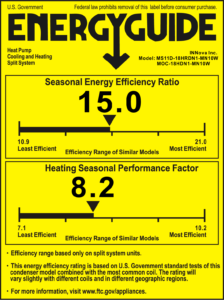The more efficient an air conditioning and heat pump unit is, the less energy it will take to cool your home. Not only does that mean that your unit does not have to work as hard, it results in a lower utility bill. Typically, the higher a unit’s efficiency is, the more expensive it can be. Knowing the SEER rating is just one of many factors to consider when making a purchase decision on an HVAC system.
What is a SEER Rating?
A SEER Rating – Seasonal Energy Efficiency Ratio (SEER) measures an air conditioning and heat pump cooling efficiency, which is calculated by the cooling output for a typical cooling season divided by the total electric energy input during the same time frame.
(Cooling Output ÷ Total Electric Energy Input = SEER Rating)
Does this still seem fuzzy? We expect that for most, it does. We’ll explain this calculation in more detail in a bit here. But first, we dive into these ratings – where they’re located on your unit and what’s considered a good rating.
How Do I Find a Unit’s Rating?

An A/C’s SEER rating is also listed near the top of the unit’s manufacturer label, where the model and serial number are listed. Look for the beginning digits of the model number. For example, a model number that begins with 15AC means the air conditioner has a SEER rating of 15.
What is a Good SEER Rating?
The higher the SEER, the more energy efficient an Air Conditioning installation will be. In Connecticut, we recommend at very least installing an AC unit with a rating of 14, but that’s bare minimum. Ratings can go as high as 25, so as you can see, you can be super energy efficient if your budget allows it.
But don’t think that energy efficiency necessarily comes with a huge price tag. Many utility companies, such as Energize Connecticut, offer lucrative rebates and discounts for home owners installing a 16 SEER rating or higher unit. Often times, you can experience instant savings, over lower rated systems, just by selecting a higher SEER rated unit. Never mind the long term savings you can experience on your utility bill.
How are SEER Ratings Calculated?
It’s rather simple, believe it or not.
- Find the BTUs per hour of your air conditioning unit. This value can be found either on the air conditioner itself or in the owner’s manual that came with the air conditioning unit.
- Find the number of watts used per hour for your unit. This value can be also found either on the unit itself or in the owner’s manual that came with the unit.
- Next, calculate the number of BTUs used in the summer months.Use 1,000 hours, which equates to about 125 days or four months, to represent the late spring and summer months when air conditioners are used. Multiply the number from step one by 1,000 to get the number of BTUs used in the summer months.
- Calculate the number of watts-hours used in the summer months by multiplying the number from step two by 1,000.
- Divide the BTUs used in the summer months (the result of step three) by the number of watts-hours consumed in the summer months (the result of step three) to arrive at the SEER rating.
Or, you can skip the math and download a free MS Excel SEER calculator from energy.gov.







